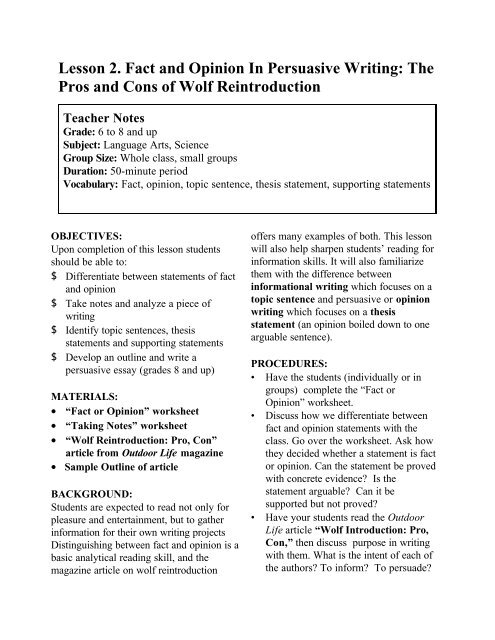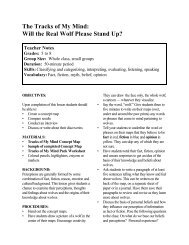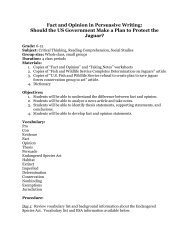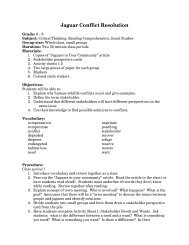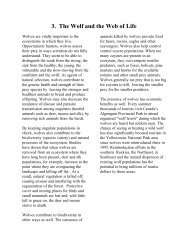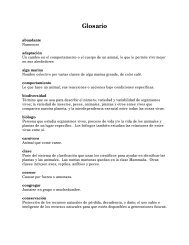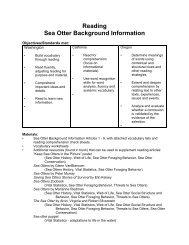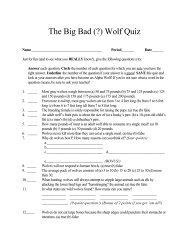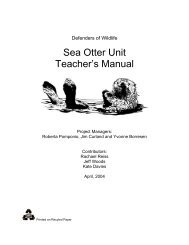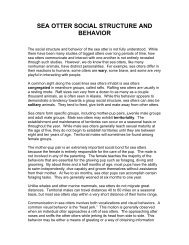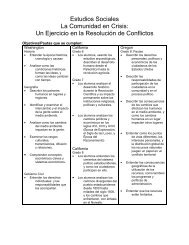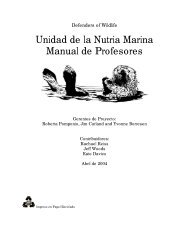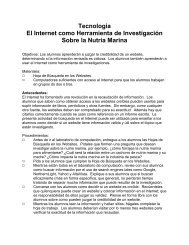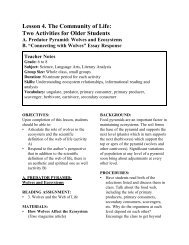Lesson 2. Fact and Opinion In Persuasive Writing: The ... - Kids' Planet
Lesson 2. Fact and Opinion In Persuasive Writing: The ... - Kids' Planet
Lesson 2. Fact and Opinion In Persuasive Writing: The ... - Kids' Planet
Create successful ePaper yourself
Turn your PDF publications into a flip-book with our unique Google optimized e-Paper software.
<strong>Lesson</strong> <strong>2.</strong> <strong>Fact</strong> <strong>and</strong> <strong>Opinion</strong> <strong>In</strong> <strong>Persuasive</strong> <strong>Writing</strong>: <strong>The</strong><br />
Pros <strong>and</strong> Cons of Wolf Reintroduction<br />
Teacher Notes<br />
Grade: 6 to 8 <strong>and</strong> up<br />
Subject: Language Arts, Science<br />
Group Size: Whole class, small groups<br />
Duration: 50-minute period<br />
Vocabulary: <strong>Fact</strong>, opinion, topic sentence, thesis statement, supporting statements<br />
OBJECTIVES:<br />
Upon completion of this lesson students<br />
should be able to:<br />
$ Differentiate between statements of fact<br />
<strong>and</strong> opinion<br />
$ Take notes <strong>and</strong> analyze a piece of<br />
writing<br />
$ Identify topic sentences, thesis<br />
statements <strong>and</strong> supporting statements<br />
$ Develop an outline <strong>and</strong> write a<br />
persuasive essay (grades 8 <strong>and</strong> up)<br />
MATERIALS:<br />
• “<strong>Fact</strong> or <strong>Opinion</strong>” worksheet<br />
• “Taking Notes” worksheet<br />
• “Wolf Reintroduction: Pro, Con”<br />
article from Outdoor Life magazine<br />
• Sample Outline of article<br />
BACKGROUND:<br />
Students are expected to read not only for<br />
pleasure <strong>and</strong> entertainment, but to gather<br />
information for their own writing projects<br />
Distinguishing between fact <strong>and</strong> opinion is a<br />
basic analytical reading skill, <strong>and</strong> the<br />
magazine article on wolf reintroduction<br />
offers many examples of both. This lesson<br />
will also help sharpen students’ reading for<br />
information skills. It will also familiarize<br />
them with the difference between<br />
informational writing which focuses on a<br />
topic sentence <strong>and</strong> persuasive or opinion<br />
writing which focuses on a thesis<br />
statement (an opinion boiled down to one<br />
arguable sentence).<br />
PROCEDURES:<br />
• Have the students (individually or in<br />
groups) complete the “<strong>Fact</strong> or<br />
<strong>Opinion</strong>” worksheet.<br />
• Discuss how we differentiate between<br />
fact <strong>and</strong> opinion statements with the<br />
class. Go over the worksheet. Ask how<br />
they decided whether a statement is fact<br />
or opinion. Can the statement be proved<br />
with concrete evidence Is the<br />
statement arguable Can it be<br />
supported but not proved<br />
• Have your students read the Outdoor<br />
Life article “Wolf <strong>In</strong>troduction: Pro,<br />
Con,” then discuss purpose in writing<br />
with them. What is the intent of each of<br />
the authors To inform To persuade
To change someone’s mind Who is<br />
their audience What is the tone of the<br />
piece<br />
FURTHER EXPLORATION:<br />
As students move from middle school to<br />
high school, they begin to acquire <strong>and</strong> refine<br />
expository <strong>and</strong> persuasive writing skills.<br />
Discuss purpose, audience <strong>and</strong> how<br />
statements of fact <strong>and</strong> opinion are used in<br />
expository <strong>and</strong> persuasive writing.<br />
Expository writing requires the student to<br />
gather information to support a topic<br />
sentence. Its purpose is to enlighten the<br />
reader, to give information, to “expose.”<br />
<strong>Persuasive</strong> writing requires the student to<br />
defend an arguable statement with evidence<br />
that supports his/her opinion. This evidence<br />
can include personal experience, the<br />
experiences of others, direct observation,<br />
statistics <strong>and</strong> observations <strong>and</strong> opinions<br />
from credible sources.<br />
• Have students read the persuasive<br />
writing pieces on wolf reintroduction,<br />
find the thesis statement <strong>and</strong> pick out the<br />
facts <strong>and</strong> opinions used to back it up.<br />
(See Sample Outline).<br />
• Discuss these elements of expository<br />
<strong>and</strong> persuasive writing with the class.<br />
You may even want to assign an<br />
independent exercise in expository or<br />
persuasive writing.
SAMPLE OUTLINE<br />
Title of Article: Wolf Reintroduction: Con<br />
Author: Jim Zumbo<br />
Topic: Wolf Reintroduction<br />
<strong>The</strong>sis: Wolves should not be reintroduced on public l<strong>and</strong>s in the United<br />
States. (This is an opinion, not a fact. Zumbo needs to support his argument by<br />
answering the question, “WHY should wolves not be reintroduced on public l<strong>and</strong>s in<br />
the United States”)<br />
Supports: (Because....)<br />
I. Wolves are not in danger of extinction in Northern Rockies<br />
A. Eyewitness reports of wolves in Yellowstone<br />
B. Not verified that wolves ever eliminated from Yellowstone<br />
J. Wolves will disperse on their own from Canada<br />
II.<br />
III.<br />
IV.<br />
Possibility wolves in U.S. Rockies are genetically distinct from Canadian wolves<br />
A. “Pure” American wolf might cease to exist<br />
Legal difficulties would occur with Endangered Species Act<br />
A. Controls would be necessary on introduced wolves<br />
B. <strong>In</strong>troduced wolves would have to be designated “experimental” or “delisted”<br />
C. Question of control – who is in charge of management<br />
Hunters would be negatively affected<br />
A. No one knows how fast wolves multiply<br />
B. No one knows how much they eat<br />
1. 100 wolves = 9,000 big game animals per year<br />
<strong>2.</strong> Studies in Alaska <strong>and</strong> Canada show severe impact on wildlife<br />
C. Hunters will never be allowed to hunt wolves<br />
V. Wolves would add to mortality of winter-distressed herds<br />
A. Herds need protection<br />
VI.<br />
Wolves documented killing more than they eat<br />
A. “Surplus” killing by wolves may further impact big game populations.<br />
1. Example: Alaska – parts of 20 Dall sheep eaten<br />
<strong>2.</strong> Yellowstone – residents claim five elk partially eaten<br />
3. Banff National Park – partially eaten elk noted
VII.<br />
Reintroduction interferes with natural migration<br />
NOTES TO TEACHERS<br />
Students should examine Zumbo’s supports for credibility. Some questions to consider:<br />
$ Were wolves ever verified to be extinct in Yellowstone (yes) By whom (Biologists, park<br />
officials) How (no tracks, no kill sites, no den sites, large coyote <strong>and</strong> elk populations)<br />
$ Who were the eyewitnesses who reported sighting wolves in Yellowstone Were these animals<br />
verified to be wolves (Possibly hybrids, possibly lone dispersers)<br />
$ Does the existence of an occasional disperser mean there is a viable breeding population (no)<br />
$ Is there such a thing as a “genetically pure” American wolf (no)<br />
$ Legal difficulties with reintroduced wolves would occur. (<strong>The</strong>y have. This prediction has come<br />
back to haunt the Yellowstone <strong>and</strong> Central Idaho reintroduction. <strong>The</strong> reintroduced wolves were<br />
designated “non-essential experimental” rather than “endangered.” This was so that<br />
reintroduced wolves could be killed if they depredated on livestock. It is illegal, however, to<br />
kill an animal that is designated “endangered.” A federal judge ruled in December of 1997 that<br />
the reintroduction of wolves to Yellowstone <strong>and</strong> to Central Idaho was illegal because there is<br />
no way an “endangered” wolf could be distinguished from an “experimental” wolf. An<br />
endangered wolf might, therefore, be killed. This court decision is being challenged by<br />
Defenders of Wildlife <strong>and</strong> others because if it is upheld, the Idaho <strong>and</strong> Yellowstone wolves<br />
will have to be destroyed since Canada cannot take them back <strong>and</strong> there are no zoos that can<br />
accommodate these wild wolves.)<br />
• Do wolves multiply in excess of their natural prey Do predators multiply so that their food<br />
source is eliminated Or does nature provide checks <strong>and</strong> balances<br />
• Which animals in a herd do wolves usually kill Why What happens when there are excessive<br />
numbers of ungulates such as elk <strong>and</strong> no “summit” predator to control their numbers<br />
• Who benefits from “wolf leftovers” when there ARE leftovers<br />
• Does reintroduction hinder natural migration What argument could be made to support this<br />
Does this matter<br />
<strong>Lesson</strong> 14. Community in Crisis: An Exercise in Conflict Resolution is an<br />
excellent follow-up to this lesson.


